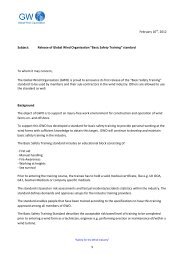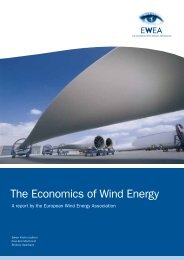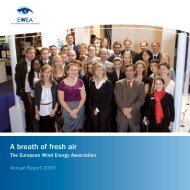Offshore Electricity Infrastructure in Europe - European Wind Energy ...
Offshore Electricity Infrastructure in Europe - European Wind Energy ...
Offshore Electricity Infrastructure in Europe - European Wind Energy ...
Create successful ePaper yourself
Turn your PDF publications into a flip-book with our unique Google optimized e-Paper software.
Annex d – details of results<br />
D.I W<strong>in</strong>d output statistics<br />
D.I.I Spatial smooth<strong>in</strong>g of<br />
w<strong>in</strong>d power<br />
There are several techno-economic benefits directly<br />
l<strong>in</strong>ked to an offshore grid as outl<strong>in</strong>ed <strong>in</strong> the <strong>in</strong>troduction.<br />
One of these benefits is the additional<br />
<strong>in</strong>terconnection of w<strong>in</strong>d energy generation centres<br />
across <strong>Europe</strong> which smoothes the w<strong>in</strong>d energy variability<br />
towards a more steady generation profile. This<br />
issue was already studied by the TradeW<strong>in</strong>d study and<br />
was further elaborated with<strong>in</strong> <strong>Offshore</strong>Grid as more<br />
accurate w<strong>in</strong>d power time series were available.<br />
This smooth<strong>in</strong>g effect is illustrated <strong>in</strong> Figure 13.1,<br />
display<strong>in</strong>g the gradients for three different sizes of<br />
regions <strong>in</strong> Denmark (a gradient is the percentage by<br />
which power goes up or down <strong>in</strong> one hour, or % fluctuation<br />
<strong>in</strong> an hour). It can clearly be seen that the<br />
gradient, or fluctuation <strong>in</strong> w<strong>in</strong>d power, is much less<br />
when look<strong>in</strong>g at a large region such as the whole of<br />
Denmark, when compared to the gradient of just one<br />
w<strong>in</strong>d farm.<br />
The effect is even more pronounced when aggregat<strong>in</strong>g<br />
on a <strong>Europe</strong>an level, as shown <strong>in</strong> Figure 13.2.<br />
Whereas offshore EU w<strong>in</strong>d power still exhibits hourly<br />
gradients of 8% dur<strong>in</strong>g a noticeable time per year, total<br />
EU w<strong>in</strong>d power (onshore plus offshore) hardly shows<br />
hourly gradients <strong>in</strong> excess of 5%.<br />
The smooth<strong>in</strong>g effect on w<strong>in</strong>d variability is clearly visible<br />
<strong>in</strong> Figure 13.3 where it is clearly shown that the<br />
w<strong>in</strong>d power generation of the <strong>Offshore</strong>Grid 2030 scenario<br />
across a large area as EU27 (<strong>in</strong>cl. Norway and<br />
Switzerland) exhibits a significantly lower variability<br />
compared to the w<strong>in</strong>d power generated <strong>in</strong> e.g. Belgium<br />
alone.<br />
A way of represent<strong>in</strong>g the beneficial effect of aggregation<br />
at power system scale is by plott<strong>in</strong>g the load<br />
duration curve of w<strong>in</strong>d power plants. This is a graph<br />
which shows how many hours the power plant is operat<strong>in</strong>g<br />
above a certa<strong>in</strong> power output. Examples for a<br />
s<strong>in</strong>gle w<strong>in</strong>d turb<strong>in</strong>e, a small country (Belgium) and the<br />
whole of the EU are given <strong>in</strong> Figure 13.4. Aggregat<strong>in</strong>g<br />
w<strong>in</strong>d power flattens the load duration curve. A s<strong>in</strong>gle<br />
offshore turb<strong>in</strong>e <strong>in</strong> this example produces rated<br />
(100%) power for 1,500 hours and zero power dur<strong>in</strong>g<br />
FiGuRe 13.1: FRequency OF Relative pOweR chanGes <strong>in</strong> <strong>in</strong>teRvals OF One hOuR FOR a s<strong>in</strong>Gle danish OFFshORe w<strong>in</strong>d<br />
FaRm, 25 danish OFFshORe w<strong>in</strong>d FaRms expected <strong>in</strong> 2030 and all w<strong>in</strong>d FaRms (On&OFFshORe) that aRe expected <strong>in</strong><br />
denmaRk <strong>in</strong> 2030. a pOsitive value ReFlects an <strong>in</strong>cRease <strong>in</strong> pOweR and a neGative value a decRease<br />
Occurence<br />
(hours per year)<br />
6,000<br />
5,000<br />
4,000<br />
3,000<br />
2,000<br />
1,000<br />
0<br />
-20 -15 -10 -5 0 5 10 15 20<br />
Total Danish w<strong>in</strong>d power 25 Danish offshore w<strong>in</strong>d parks 1 Danish offshore park<br />
128 <strong>Offshore</strong>Grid – F<strong>in</strong>al Report









